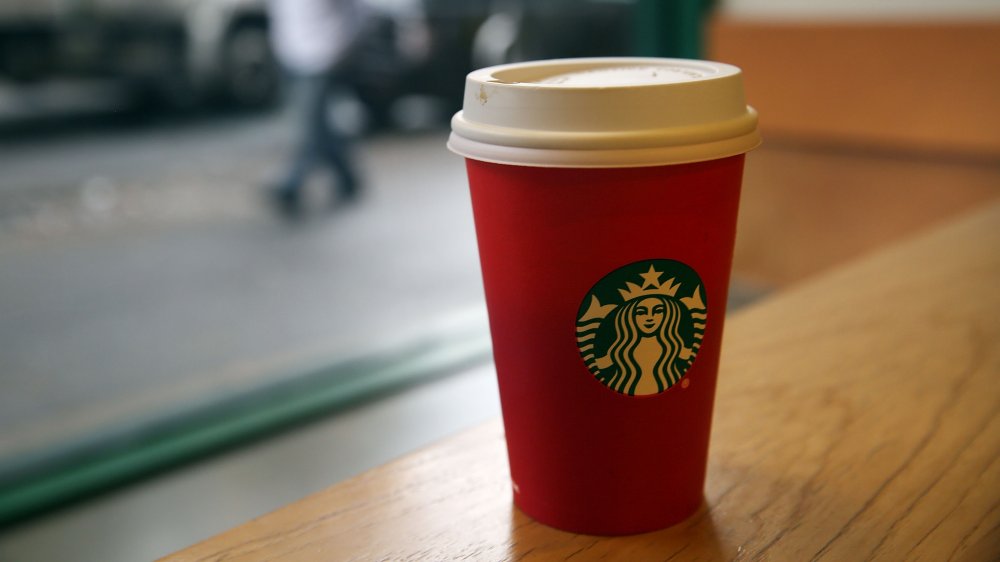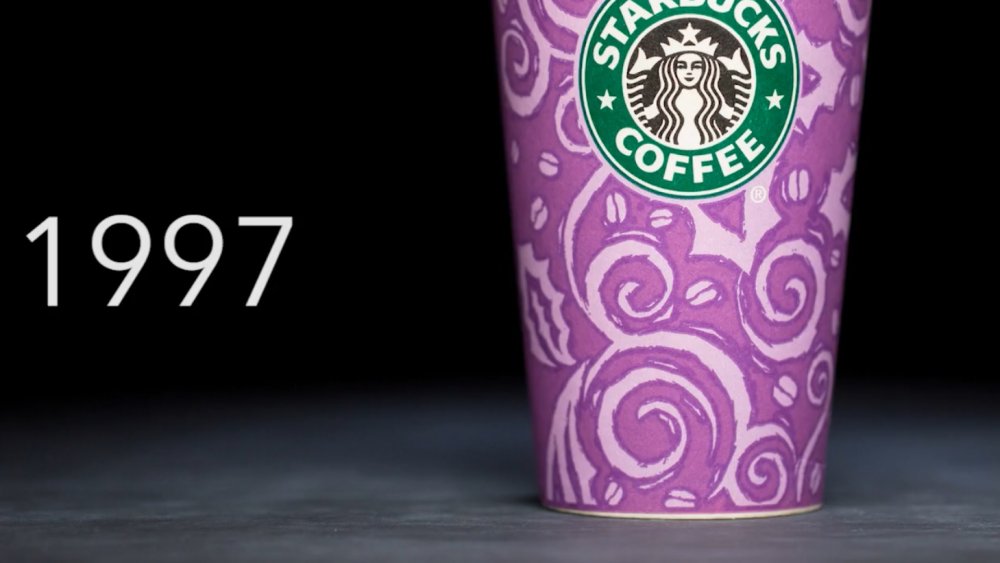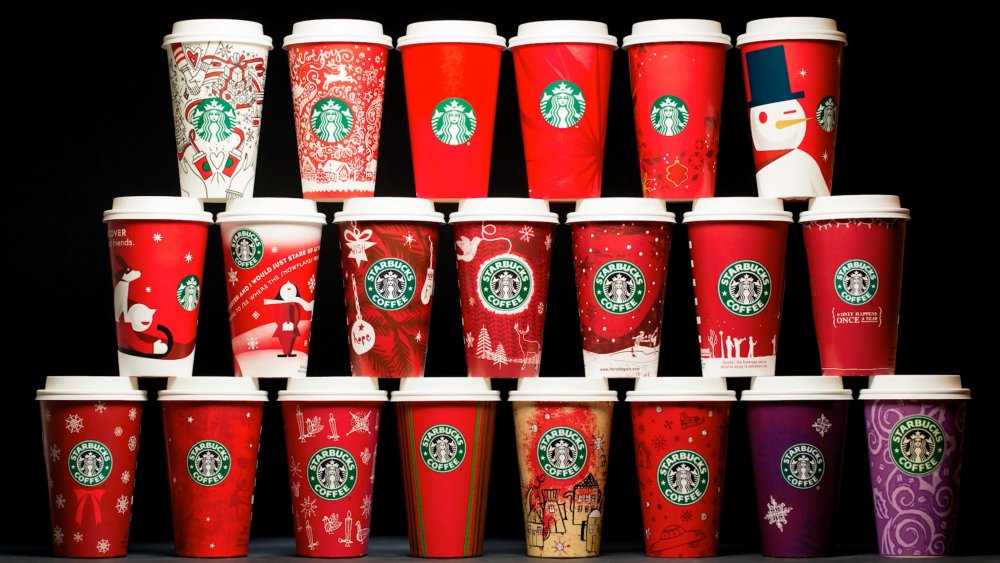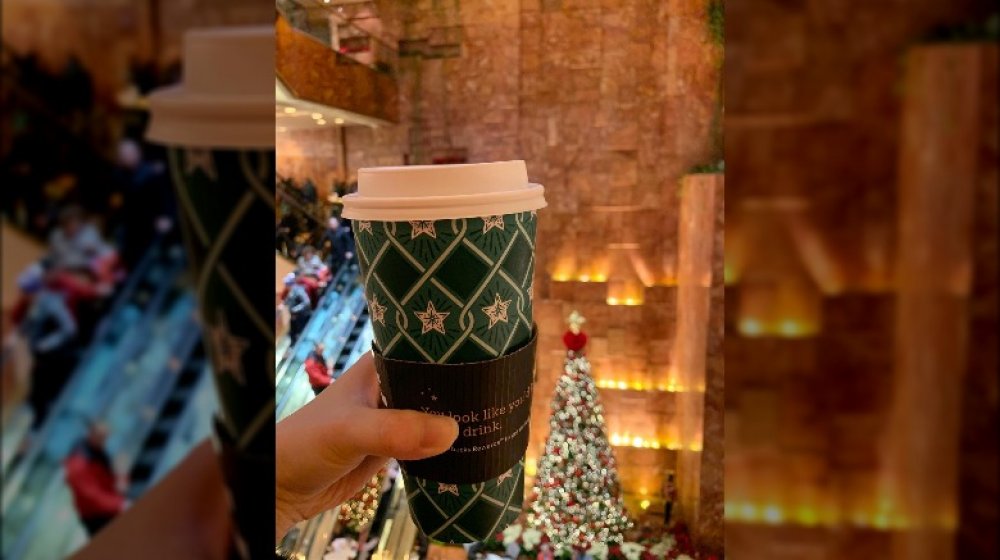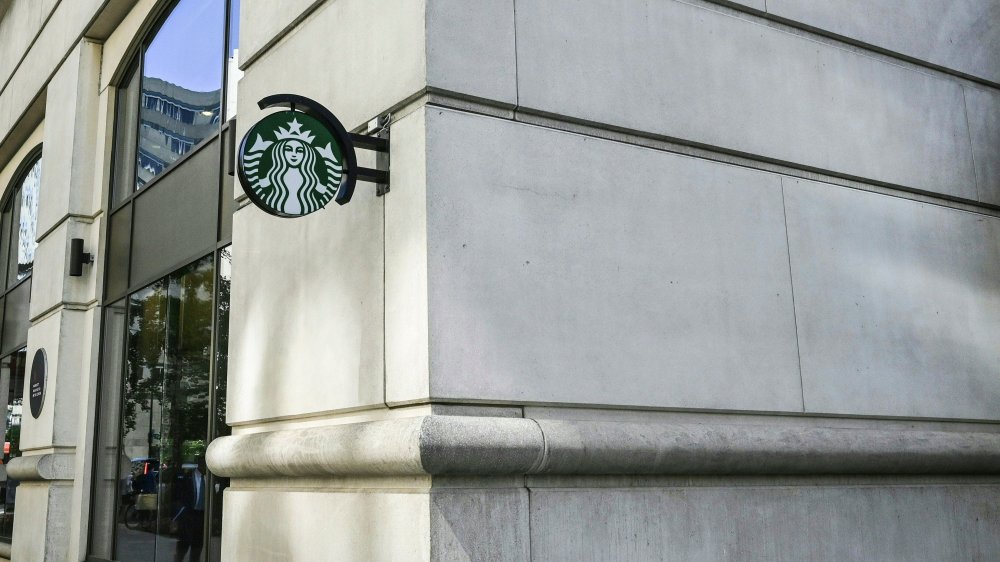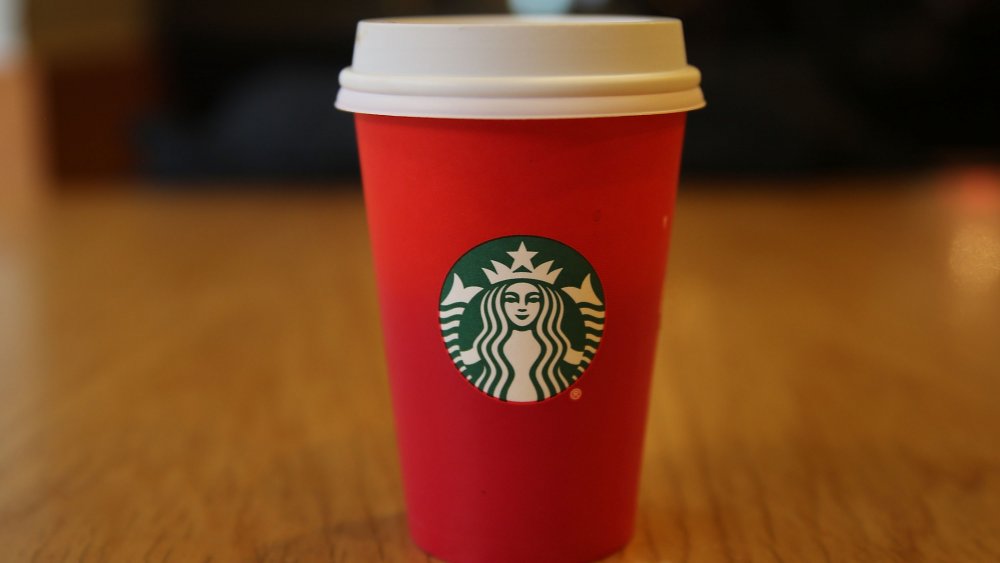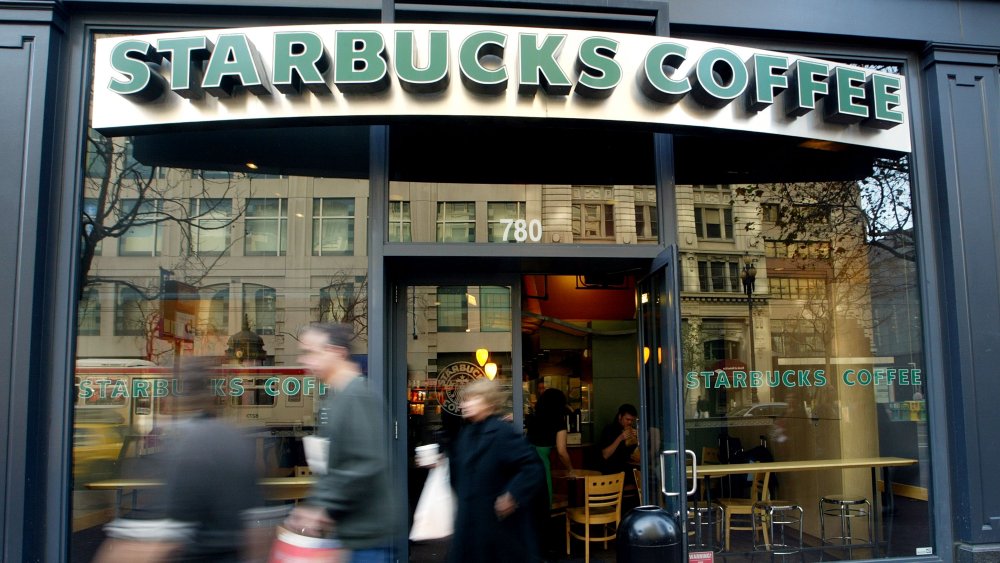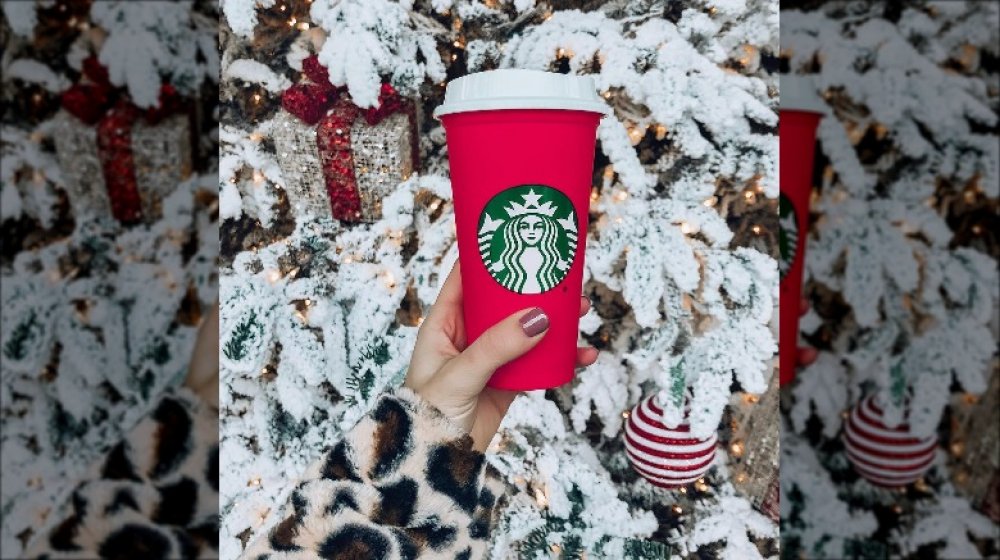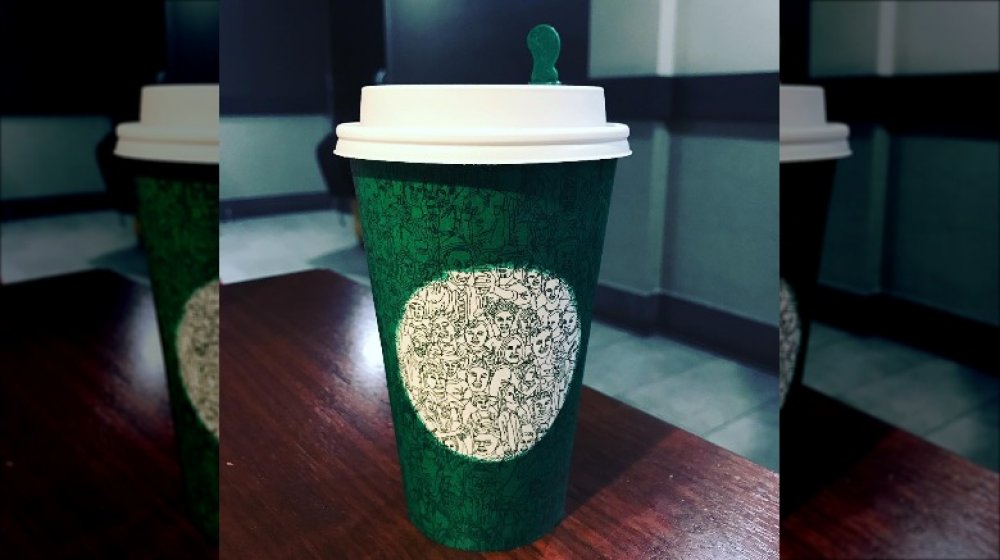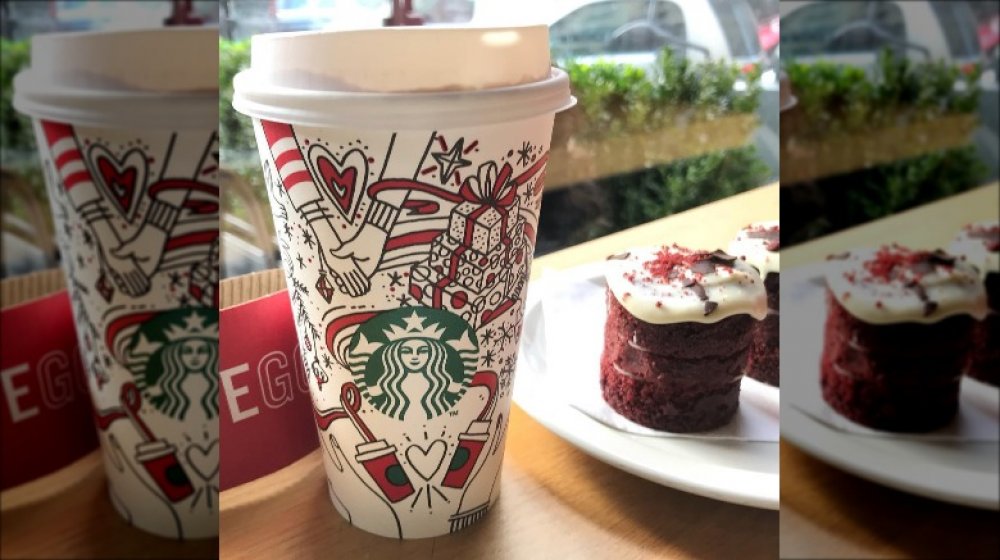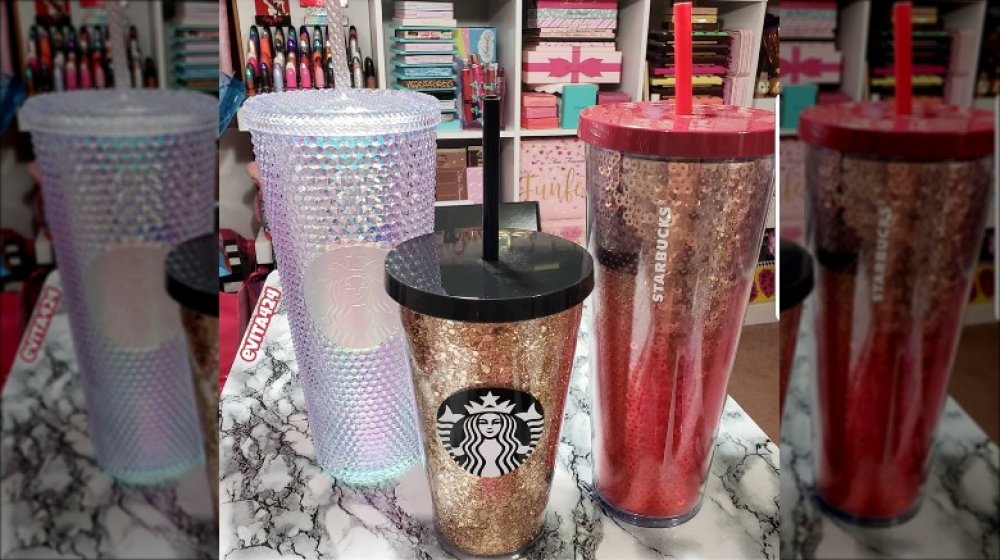The Untold Truth Of Starbucks Red Cups
Although they've been around for over two decades now, there's a good chance that Starbucks' infamous red holiday cups have only caught your eye in the last couple of years — whether you're a fan of Starbucks or not. That's because of a few different reasons. The first reason is likely the fact that word of mouth spreads so much quicker on the internet (something that just didn't happen so much in the '90s), but Starbucks has also put a lot more effort into hocking their limited edition holiday cups in recent years. And then, of course, there are the controversies — oh, the many, many strange and highly-publicized controversies — that have basically forced the red (or sometimes not) holiday cups from Starbucks onto your radar year after year.
Before they return to Starbucks shelves this Christmas —and you know they're coming — why not take a dive into the ins and outs of this weirdly contentious holiday item? At the very least, it'll gear you up for whatever new disputes and arguments the Christmas 2019 Starbucks cups will surely bring the company, its fans, and its haters. From their surprisingly simple (and not red) origins, to their many varieties, to the newsworthy rows that put them on the map, here's the untold truth of Starbucks' red cups. There's a lot more to it than you think.
The Starbucks red cups had humble beginnings
The history of these not-so-little red cups is best told by the company themselves. According to Starbucks, the holiday cups first debuted in stores way back in 1997. Unfortunately, few records exist of these early cups, because most were thrown away, the design files were lost in a 2001 earthquake, and people weren't exactly scrambling to upload their Starbucks cup photos to Instagram way back then. It was a different time in the 1990s.
Anyway, ex-Starbucks designer Sandy Nelson explains the process these early cups underwent. "It was August," she says, "and I had just started with the company. We were working on holiday creative for the season to come. We had what felt like a hundred cup designs pinned up on the wall. Then Howard [Schultz] came by, looked at all of them, and picked my design. I couldn't believe mine was chosen."
That early cup was more magenta than red, but it also came in sapphire, emerald and amethyst — all slight variations on actual Christmas colors. It featured hand-drawn holly leaves and a load of lovely swirly patterns.
It wasn't until 1999 that the Starbucks holiday cup actually became red, after much debate over what the correct color of Christmas red actually is, and from then the cups' popularity only grew. Now, it's featured on morning talk shows, joked about in late night stand-up shows and is eagerly awaited by Starbucks fans on social media. Not bad for a little red cup.
Starbucks red cups are an evolving design
So just how have those designs developed over the years? Well, 1999's brand new red design upped the whimsy considerably, throwing in black doodles of Christmasy things like snowflakes, ice skates and what appears to be either a car or a UFO. Surprisingly, by 2000 the red had almost vanished again with the advent of a kraft paper-colored cup (featuring only a splash of red), meant to coincide with the release of the Gingerbread Latte. From there, however, the red coloring became a staple, with only the design itself changing over time.
The 00s saw these cups bear the images of stars, snowflakes, wreaths, mistletoe, fairy lights, holiday silhouettes, reindeer, doves, trees, decorations and — well, you know... Christmas stuff. A new decade, however, saw a new design take shape, and 2010's cup featured a red/white color scheme, a more modern feel and a number of depictions featuring holiday characters trying to catch snowflakes. 2011 and 2012 saw more focus on these kinds of characters, focusing in particular on carolers, ice skaters, sledders and snowmen, generally making for sleeker, more light-hearted cups than those that came before.
2013 saw a return to the traditional, 00s-style cup, which was followed on in 2014. And then, in 2015... the world ended. But more on that later.
There are always new varieties of Starbucks red cups
Now, you already know that the 1997 version of the Starbucks holiday cups came in magenta (and a few other colors) rather than a true holiday red, but it's also true that color variations also exist on much later versions. Even as recently as 2018, Starbucks released a number of varieties that went far beyond the plain and simple red color of the main cup.
One of these was a green cup featuring a latticed design and star ornaments. Another was a white and green cup that featured holly leaves and berries, while the third was a trippy red and white design that, if you ask us, kinda evokes the imagery of a roaring fire. The final cup was a simple red strip design. Nice, right? According to a Starbucks press release (via People), these designs (which the company described as "retro") were inspired by the "nostalgic and joyful taste of the season."
The Starbucks red cups can sell out
To say that these red cups are popular would be one hell of an understatement — and nothing illustrates that better than 2018's big debacle.
Here's what went down: when the red cups first went on sale at the beginning of November, the lineup included a reusable red cup that would get customers a 50 cent discount on drinks during certain hours of the holiday season. The cup was free and available for one day only, but many Starbucks fans were shocked to discover that pretty much every store they could find had totally sold out of the darn things very early in the day.
Those same customers flocked to Twitter to voice their distaste. "Went to Starbucks and ordered a holiday drink just to get the red reusable cup that came with it," said one, "person in front of me got the last cup. Story of my life."
"Super sad I went to @Starbucks," said another, "and waited in [line] for like 20 mins for the red cup and they were out."
Some customers admitted to having tried up to three different stores to get their hands on their cups, with one even managing to get a cup with no lid. One barista for the chain told CNBC that their store had run out of cups by noon on the day of release, while another said they were gone by 3 p.m.
So yeah, basically: people really, really like these things.
Starbucks red cups make serious dollar
Obviously, it should go without saying that people loving these red cups means Starbucks makes an absolute boatload of money of them, too. Take 2015, for example, a year when red cup controversy was at its peak. Despite significant pushback from certain groups (we'll get to that in a minute, we promise), Starbucks reaped strong profits over the season thanks, at least in part, to the holiday cups.
In 13 weeks, Starbucks made a total sales figure of $5.37 billion, up over 11 percent on the same period of time in 2014. Now, $1.9 billion of that came from gift cards alone (and that's kind of amazing in itself), while much of it appears to have come from demand for the chain's pumpkin spice lattes. Still, the red cups are likely to have had a major impact too, and there's a good chance that their grabbing of the headlines that year only served to increase sales for the company.
Unfortunately for Starbucks, their European and Asian performances were less impressive than America, a disappointment largely put down to a strong dollar and terror attacks on the European continent. Then again, you have to ask... maybe Europeans just aren't as into the red cups. But hey, that's just a theory.
Starbucks used the red cups to go green
One question still remains, of course — aside from making Starbucks a ton of money and giving everyone something to argue about for a few months, what's the point of these red cups? Are they really just a limited edition trinket aimed at keeping people feeling festive for a few weeks a year?
Well, no, they do actually have one other purpose — or at least some of them do. One of the aims of the push towards selling red cups in a reusable format (like the ones that sold out in 2018), is cutting down on waste that builds up from people using the standard Starbucks coffee cups. Starbucks encouraged this by implementing a rule with the reusable red cups: if you bought one of their drinks and had them make it in the reusable red cup you brought along, you would get a 50 cent discount on that drink — and that counted anytime after 2 p.m. over the entire Christmas period.
Of this rule, Starbucks Chief Operating Officer Rosalind Brewer said: "We're really trying to create a habit here. When we know that people are most likely paying attention to our cups, we want to make sure we get this out in front of them."
So there you have it — Starbucks really are keen on pushing the environmental benefits reusing those red cups. Though all that money they'll make probably isn't hurting them, either.
The Starbucks red cup war on Christmas, Part I
And now, inevitably, we come to those controversies. Yes, despite all the fascinating aspects of the Starbucks red cups and their history, the one thing for which they're now most well-known is kicking up a serious fuss whenever they roll into town.
The first controversy took place in 2015. As you might have noticed, Starbucks' design for the red cup that year was strikingly simple: red, tall, no decorations. That's it. And while most people might be a little peeved by the lack of effort Starbucks put into their 2015 design, that's nothing compared to what some people got very peeved about.
This palava began with a man named Joshua Feuerstein, an internet viral video "star" who describes himself as a "disciple of Jesus". Feuerstein has been a proponent for anti-evolution views and once claimed the "Christian Holocaust has begun" after a Kentucky clerk was jailed for refusing to sign a gay marriage license.
So in 2015, Feuerstein made headlines after releasing a video in which he decried Starbucks for removing Christmas imagery from their cups, part of what he and other conservative Christians call the "war on Christmas." Millions of people watched this video in the days after it was released, and the scandal reached kind of a low after none other than Donald J. Trump got involved, suggesting a boycott of the coffee chain.
In case you're wondering, Starbucks released several Christmas-themed pieces of merchandise in 2015, proving Feuerstein's now-notorious insistence that Starbucks aren't allowed to say "Merry Christmas" was a total lie.
The Starbucks red cup war on Christmas, Part II
But if you thought 2015 was to be the end of the red cups' role in the so-called war on Christmas, boy, have you got it wrong. The controversy continued in 2016 when Starbucks made the lamentable mistake of introducing green cups to their range. In a statement that coincided with the cups' release, Starbucks CEO Howard Schultz explained that this new design represented "a symbol of unity as a reminder of our shared values, and the need to be good to each other."
This made some people... very mad indeed. NBC News reported on Twitter users accusing Starbucks of everything from "political brainwashing" to attacking Christian values to spreading "liberal bias."
"RT if you think @Starbucks is trying to take Jesus out of Christmas with the new cup," tweeted one user. "Now that beloved diversity has blown up in our faces," said another, "the libs @Starbucks have begun shilling for unity." One user complained "Screw you. My coffee should NOT (and does NOT) come with political brainwashing." Yet another insisted: "Lifelong customer becoming disgusting with the forced agenda."
But do you want to know the really great thing about all this? The green cup wasn't even Starbucks' only holiday cup for 2016, but was instead created solely to send a message of unity and hope to the United States in the wake of an electoral campaign that had split the country apart. Another holiday cup — this time in red — was released shortly after.
The Starbucks red cup was accused of supporting a "gay agenda"
Somewhat predictably, 2017 saw yet another controversy hit Starbucks' annual release of Christmas cups — and this one came out of nowhere.
The 2017 Starbucks holiday cup featured a red and white motif and all kinds of festive decorations including gifts, Christmas trees and stars. This very Christmassy motif seems to have disappointed a certain subset of people who had clearly been looking forward to tweeting their outrage about the war on Christmas to some poor Starbucks social media intern. Naturally, they found something else to get outraged about out instead.
You see, this cup also featured a doodle of two people holding hands. Only the arms are visible, which means the people attached to them could be — well, they could be anyone. Buzzfeed News immediately ran an article in which they celebrated the inception of what they said people were calling a "totally gay" cup, likely spurred on by the commercial Starbucks released to coincide with the cups that featured a lesbian couple holding hands at the end.
Now, this time Twitter users were relatively quiet on the matter (save for a few who accused Starbucks of pushing a "gay agenda"), but Fox News leapt into the fray nonetheless, running a story suggesting that the chain had come under heavy criticism for its portrayal of LGBTQ+ people in its marketing.
When asked by The New York Times to explain the cup, Starbucks responded (via Salon): "This year's hand-drawn cup features scenes of celebrating with loved ones — whoever they may be... We intentionally designed the cup so our customers can interpret it in their own way, adding their own color and illustrations."
Well, mission accomplished on that one, Starbucks.
2019 will be about more than red cups at Starbucks
As early as September 25 2019, Starbucks revealed the designs for the year's Christmas cups — not the red paper cups, but the tumblers they'll offer for retail sale. All of these cups will retail for around $20 (and no more than $25) and will be available to buy on November 1.
The first pair of designs are iridescent 24-ounce cold cups, made in the company's now-iconic spiked design, in both "Bling Platinum" and neon pink. These ones go for $19.95 each. Then you've got the Mirror Glitter Gold Cold Cup, which aside from being a mouthful (both literally and figuratively, at 24-ounces) feature a groovy sheet of speckled snow-white over muted gold. $18.95 each, cup fans.
Next up is the Green Confetti Tumbler, a hugely colorful 12-ounce cup that, let's face it, is just begging to be filled with a cocktail. $19.95 for that one. The Glitter Gradient Cold Cup, meanwhile, is pink and shiny and not much else ($22.95), the Pink Cold Cup is pinker and shinier ($18.95) and the Gold Water Bottle is... well, it's exactly what it sounds like. And it's $22.95.
So there you have it: for 2019, Starbucks' Christmas limited edition cups are shiny, wintry, funky and very much not red for the most part. Maybe the paper cups will be more of the red variety, but we'll have to wait and see.
